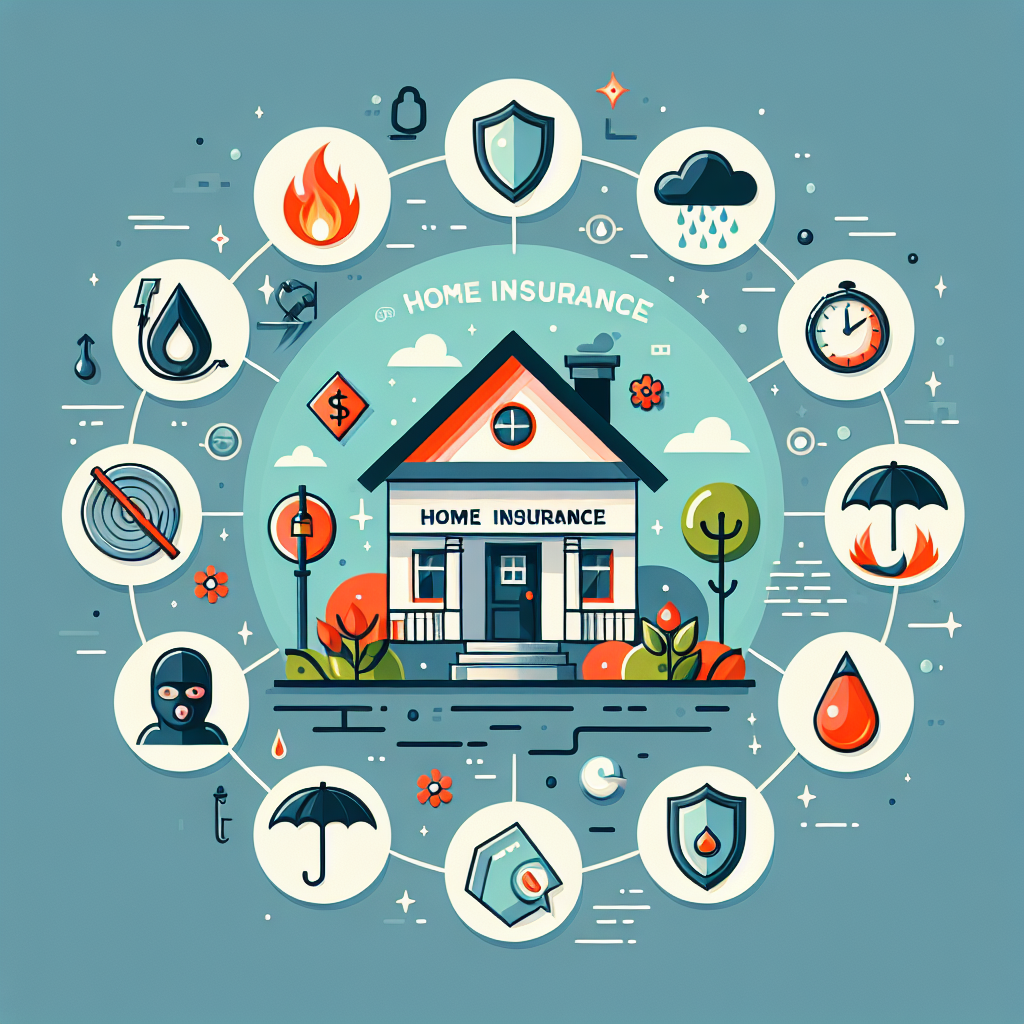Filed under Home Insurance on
Home Insurance Coverage Explained: A Simple Guide

Why homeowners insurance still matters more than ever
Storms are stronger, construction costs have climbed, and insurers are rethinking risk. In this environment, understanding exactly what your policy does—and doesn’t—do is essential. Consider this your plain-English walk-through of the essentials. This simple guide aims to demystify the policy language, help you choose smarter protection, and give you practical steps to keep costs in check. If you have ever felt overwhelmed by fine print, you are in the right place for home insurance coverage explained clearly and confidently.
The building blocks of a homeowners policy
Most owner-occupied homes are insured with a form commonly called HO-3 (or HO-5 for broader protection). Regardless of the form, the core parts are similar. Think of the policy as a bundle of six primary protections working together to keep your household financially resilient.
Dwelling (Coverage A)
This is the backbone of the policy. It pays to repair or rebuild your house when a covered peril causes damage. Limits should reflect the full cost to rebuild at today’s labor and material prices, not the home’s market value. That means factoring in contractor overhead, debris removal, and current building codes. A reliable replacement cost estimate is foundational to any home insurance coverage strategy.
Other structures (Coverage B)
Detached garages, fences, sheds, and gazebos fall here. The limit is commonly set at 10% of your dwelling limit by default, but you can increase it if your property includes significant outbuildings.
Personal property (Coverage C)
This covers your belongings—furniture, clothes, electronics—anywhere in the world. A typical limit is 50% to 70% of the dwelling limit, but sub-limits apply to certain categories, especially theft-prone items. It is common to see capped amounts for jewelry, watches, firearms, silverware, and cash. To protect high-value items fully, you may need to “schedule” them or boost sub-limits through an endorsement.
Loss of use or additional living expenses (Coverage D)
If a covered loss makes your home uninhabitable, this pays for temporary housing, meals, pet boarding, and related costs. Keep receipts and track expenses carefully—insurers reimburse reasonable, necessary costs above your typical spending until the home is repaired or you relocate permanently, up to policy limits.
Personal liability (Coverage E)
Liability protection pays for injuries or property damage you are legally responsible for, plus legal defense. It can also cover “personal injury” such as libel and slander if you add a specific endorsement. Many households choose limits of $300,000 to $500,000, and those with assets or income to protect often add a $1 million or larger umbrella policy for extra peace of mind.
Medical payments to others (Coverage F)
Regardless of fault, this covers small medical bills for guests injured on your property. Limits are usually modest—often $1,000 to $5,000—but it helps resolve minor injuries quickly without a liability dispute.
What your policy actually covers—and what it means
Two concepts define the scope of protection: covered perils and the way losses are valued. Most HO-3 policies protect the dwelling on an “open perils” basis, meaning all causes of loss are covered unless excluded. Personal property is typically “named perils,” covering only listed causes such as fire, theft, and wind, though an HO-5 policy often extends open perils coverage to personal property as well.
Common covered perils
Theft, fire and smoke, lightning, wind and hail, vandalism, explosion, freezing and burst pipes, falling objects, and accidental overflow of water from household systems are among the usual suspects. Because coverage can vary by state and insurer, always check the exact wording of your contract.
Replacement cost vs. actual cash value
These terms determine how much you receive after a loss. Replacement cost pays what it takes to rebuild or replace today, without depreciation. Actual cash value subtracts depreciation for age and wear. For many households, choosing replacement cost on both the dwelling and personal property is worth the small premium increase, especially for items like electronics and furniture that lose value quickly.
Policy forms in plain language
Policy forms are simply different packages of protections and perils. HO-2 is named perils for home and contents. HO-3 is open perils for the structure and named perils for belongings. HO-5 typically broadens protection further, including open perils for belongings and more favorable terms. HO-6 is for condos, HO-7 for mobile homes in many markets, and HO-8 often insures older or historic homes with unique rebuilding constraints. Choosing the right form is about matching breadth of protection to your needs and budget, and ensuring your home insurance coverage aligns with the risks you actually face.
What is not covered—and how to fill the gaps
Insurance is a contract of specific promises, and the exclusions matter. Standard policies exclude flood, earthquake, and earth movement; power failure off premises; wear and tear; neglect; intentional loss; war; nuclear hazards; and damage from pests like termites. Water that backs up through sewers or drains is also excluded unless you add an endorsement. Understanding these boundaries is how you avoid unpleasant surprises and strengthen your protection where it is thin.
Flood
Flood is not covered by homeowners insurance. If your property has any risk—from rivers and coastal storm surge to heavy rainfall and overwhelmed storm drains—look into a separate policy. Options include the National Flood Insurance Program and private flood insurers, which sometimes offer higher limits, shorter waiting periods, and additional coverages.
Earthquake and earth movement
Earthquakes, sinkholes, and landslides require separate coverage or a state-backed program in certain regions. Deductibles are often expressed as a percentage of the dwelling limit rather than a flat amount, so assess your true out-of-pocket exposure before buying.
Sewer and drain backup
This is a frequent and costly surprise for homeowners. A water backup endorsement is relatively affordable and can save thousands. Consider pairing it with a sump pump failure endorsement if your home has a basement or a high water table.
Ordinance or law
When repairs must meet newer building codes, the additional cost can be substantial. Ordinance or law coverage helps pay to bring damaged portions of your home up to code and sometimes addresses undamaged parts that have to be upgraded because of code requirements. Many policies include 10% by default; older homes often need more—25% or even 50% is not unusual.
How to set the right limits
Coverage is only effective if the limits match the real cost of rebuilding and replacing. A careful approach brings together accurate data, a realistic view of risk, and a willingness to update annually.
Dwelling limit
Use a professional replacement cost estimator that accounts for square footage, number of stories, roof type, custom features, materials, and local labor. Revisit the number each year; inflation guard endorsements can help keep pace with rising costs. Extended replacement cost—typically adding 25% to 50% above your limit—provides cushion if construction prices surge after a catastrophe.
Personal property
Make a home inventory with photos or video and store it in the cloud. For high-value items, ask about scheduling, which lists them individually with agreed values and often provides broader perils coverage and zero deductible. Review sub-limits for jewelry, collectibles, musical instruments, and art; adjust as needed.
Liability
Match your limit to your asset profile. If you own rental property, have significant savings, or are high-profile online, a higher liability limit and a personal umbrella policy help protect against lawsuits for injuries, property damage, and even certain personal injury claims like libel or slander with the correct endorsement.
Additional living expenses
Estimate the true cost of living elsewhere for several months—rents, pet boarding, commuting, and meals. In dense markets, short-term rental costs can be much higher than expected. Ensure your limit can handle a realistic timeframe for repairs, especially if local contractors are in short supply after large disasters.
Deductibles and special deductibles
Your deductible is what you pay before the policy responds. Higher deductibles typically lower premiums and discourage small claims that can raise rates. In coastal or storm-prone states, you may also see separate wind, hail, or hurricane deductibles expressed as a percentage of the dwelling limit. Align these with your emergency fund so you are comfortable with the out-of-pocket risk you are taking on.
Smart endorsements that pull their weight
Endorsements customize protection. The best ones depend on your home, lifestyle, and region, but several provide strong value for many households.
Replacement cost on contents
Upgrading personal property from actual cash value to replacement cost is one of the most cost-effective improvements you can make.
Water backup and sump overflow
Often overlooked, this covers a common and messy loss scenario. It is a must-have for many basements and older sewer systems.
Service line coverage
Buried utility lines that you own—water, sewer, power—can fail due to wear, tree roots, or freezing. Service line coverage helps with excavation, repair, and restoration.
Equipment breakdown
This helps when major systems like HVAC or appliances fail due to mechanical or electrical breakdown. It can be an affordable add-on for households with complex systems.
Ordinance or law increase
Particularly important for older homes where code upgrades can be extensive and expensive.
Home-based business and cyber
If you run a business from home, you may need specific coverage for business property, inventory, and liability. As more of life moves online, cyber endorsements can provide help after identity theft, cyberbullying-related claims, or a personal data breach.
What drives the price of your policy
Price reflects risk—both yours and your community’s. Insurers weigh home features, local peril trends, and your personal risk profile to set premiums.
Location and construction
Proximity to fire stations and hydrants, wildfire risk, coastal wind exposure, crime rates, and even the slope of your lot can affect rates. Brick or fire-resistant construction often scores better than wood-frame. Roof age, shape, and materials matter—impact-resistant shingles or a fortified roof can earn credits in many states.
Claim history and credit-based factors
Insurers review prior claims on the property and your personal claim history. In many states, credit-based insurance scores influence pricing; some states restrict or prohibit this. Ask your agent what rules apply where you live.
Household features and safety
Swimming pools, trampolines, and certain dog breeds can increase liability risk. Conversely, monitored alarms, water leak sensors, automatic water shutoff devices, and whole-home surge protection can produce discounts and prevent losses in the first place.
Market forces
Industry-wide costs, from reinsurance to building materials, affect everyone. In recent years, carriers have adjusted rates and underwriting in response to more frequent and severe catastrophes. Some regions have seen insurers limit new policies or tighten eligibility while state “FAIR Plans” serve as last-resort options. Keeping your property well-maintained and mitigated can help you remain attractive to insurers even during tight markets.
How to shop like a pro
Comparing apples to apples is the secret. Gather quotes with identical dwelling limits, matching deductibles, and the same endorsements and valuation options. Read sample policies, not just summaries. Check financial strength ratings from independent rating agencies, and ask how claims are handled—turnaround time, preferred contractors, and whether they offer emergency assistance services. When comparing quotes for home insurance coverage, focus on the long-term relationship and service quality, not just the lowest price on day one.
Bundle and save—strategically
Bundling home and auto often saves money, but verify that each component remains competitively priced. A great bundle rate should not mask a subpar policy. Ask about loyalty discounts, protective device credits, and mitigation credits for fire-resistant landscaping or fortified roofing.
Annual checkup
Review your policy annually or after major changes: renovations, an upgraded kitchen, adding a deck, installing solar, or acquiring valuable items. Bring your agent updated photos and any major receipts. Adjust limits before a loss, not after.
What to do after a loss
A calm, methodical approach preserves your options and speeds up recovery.
Safety first, then prevent further damage
Turn off water or electricity if needed, board up openings, and use tarps to prevent additional damage. Keep receipts—reasonable emergency expenses are generally covered.
Document everything
Take clear photos and video of all affected areas before cleanup. Make a list of damaged items with brand, age, model, and estimated cost. Your home inventory will pay off here.
File promptly and communicate
Report the claim to your insurer as soon as possible. Ask about next steps, timelines, and preferred vendors. Keep a log of calls and emails, and save invoices and correspondence. If a contractor proposes an assignment of benefits, understand how it affects your control over the claim before signing.
Understand how payments work
Many claims pay in stages. You might receive an initial actual cash value payment, followed by replacement cost when you submit repair receipts or proof of replacement. For large claims, familiarize yourself with the appraisal clause, which outlines a process to resolve valuation disputes without going to court.
Current trends shaping homeowners insurance
Several forces are redefining risk and coverage, and staying aware of them helps you make better decisions:
Climate and catastrophe risk
Risk models show increasing frequency and severity of hail, wildfire, and extreme rainfall in many regions. This affects where insurers write policies, what deductibles they require, and how they price wind and hail. Some carriers are offering discounts for proactive mitigation—clearing defensible space, installing ember-resistant vents, or choosing impact-resistant roofing.
Construction inflation and supply chains
Even when inflation cools, skilled labor shortages and supply chain dynamics can keep rebuilding costs elevated. Extended replacement cost and inflation guard endorsements can help you keep pace with these realities.
Smart-home risk prevention
Sensors that detect water leaks, shutoff valves that respond automatically, smoke and CO monitoring, and whole-home surge protection reduce losses and sometimes earn significant credits. Some insurers offer device subsidies or premium incentives to encourage adoption.
Data-driven underwriting
Carriers increasingly use granular data—roof condition analytics, property-level wildfire scores, and historical weather patterns. Good maintenance and mitigation can move your profile into a more favorable risk tier, especially when documented.
Myths that can cost you money
Market value equals rebuild cost: In most cases, it does not. Land is not insured, and custom features can be expensive to replicate. Rely on a replacement cost estimate, not a recent sales price.
Flood is included: It is not. Heavy rain and storm surge are excluded without separate flood insurance.
All personal items are fully covered: Sub-limits apply to valuables. Schedule them or increase sub-limits to avoid underinsurance.
Small claims do not matter: Even minor claims can raise premiums or affect eligibility. Use your deductible strategically and focus on preventing losses.
A quick roadmap to balancing cost and protection
Start with accurate dwelling replacement cost; add extended replacement for cushion. Choose replacement cost on contents to avoid depreciation hits. Increase liability limits and consider an umbrella if you have assets to protect. Add endorsements where you are exposed—water backup, service line, and ordinance or law are common winners. Then capture discounts with smart-home protection and a fortified or impact-resistant roof if feasible. Review annually as your life and the market change.
Frequently asked questions
Is my home office covered?
Personal-use equipment is typically covered, but business property and liability have tight limits without endorsements. If clients visit your home or you store inventory, consider a home business endorsement or a separate business policy.
What if my contractor quote is higher than the insurer’s estimate?
Share the detailed, line-item estimate with your adjuster. Most carriers will reconcile legitimate price differences, especially when you provide competing bids or local cost documentation. The appraisal process can help if disagreements persist.
Can I choose my own contractor?
Usually yes. Insurers may have preferred networks with guarantees, but you can select your own licensed, insured contractor. Keep in mind that payment schedules and documentation requirements will still apply.
Do I need coverage for short-term rentals?
Yes. Short-term rental activity often changes your risk profile and may exclude certain claims unless you disclose it. Ask about a rental endorsement or a specialized landlord or homeshare policy.
Putting it all together
You do not need to be an insurance professional to make strong decisions—you just need a clear plan. Start by understanding your policy’s core parts and exclusions. Identify your weak spots—flood, water backup, code upgrades, and high-value items are common gaps. Right-size your limits with current rebuild costs and inventory your belongings to avoid guesswork. Then reduce losses before they happen with smart mitigations and maintenance. This approach keeps premiums efficient while protecting what matters.
Final word: Confidence beats complexity
The goal is not perfection; it is resilience. Markets will change, storms will come, and costs will move. But with your policy tuned to your actual needs, an annual review, and a few high-impact endorsements, you will navigate those changes with far less stress. When you encounter a renewal spike or a new underwriting rule, you will have the context to ask sharp questions and adjust intelligently. Mastering home insurance coverage is less about memorizing jargon and more about aligning protection with your real-world risks.
Action steps you can take this week
Request a fresh replacement cost estimate from your agent and verify that your limit includes local labor rates and debris removal. Upgrade to replacement cost on contents if you have not already. Review sub-limits for jewelry and collectibles and schedule items as needed. Ask for quotes on water backup, service line, and increased ordinance or law coverage. Document your home with a quick video walkthrough and store it in the cloud. Finally, explore mitigation credits—impact-resistant roofing, monitored leak detection, and defensible space in wildfire areas can lower risk and, in many cases, your premium.
Closing thought
Insurance works best when it is proactive, not reactive. Use this knowledge to calibrate your policy now, so the next surprise is manageable rather than overwhelming. With the fundamentals in hand and home insurance coverage integrated into your larger financial plan, you will be positioned to protect your home, your budget, and your peace of mind.





